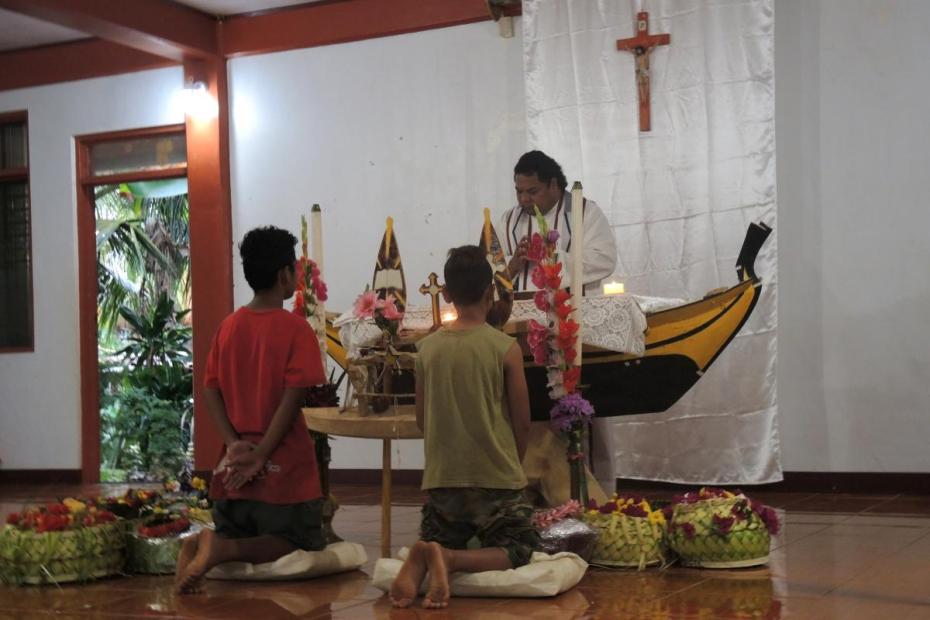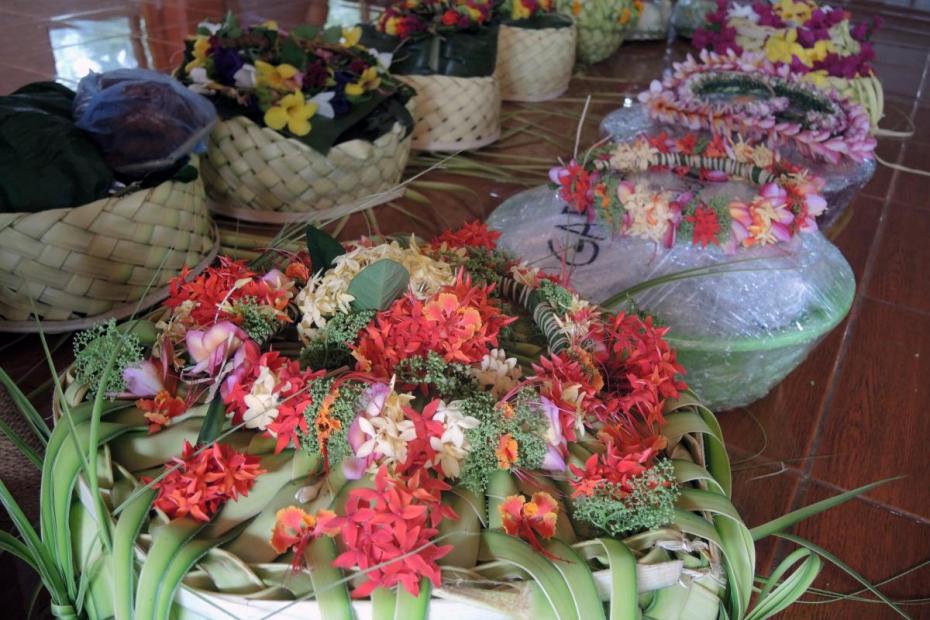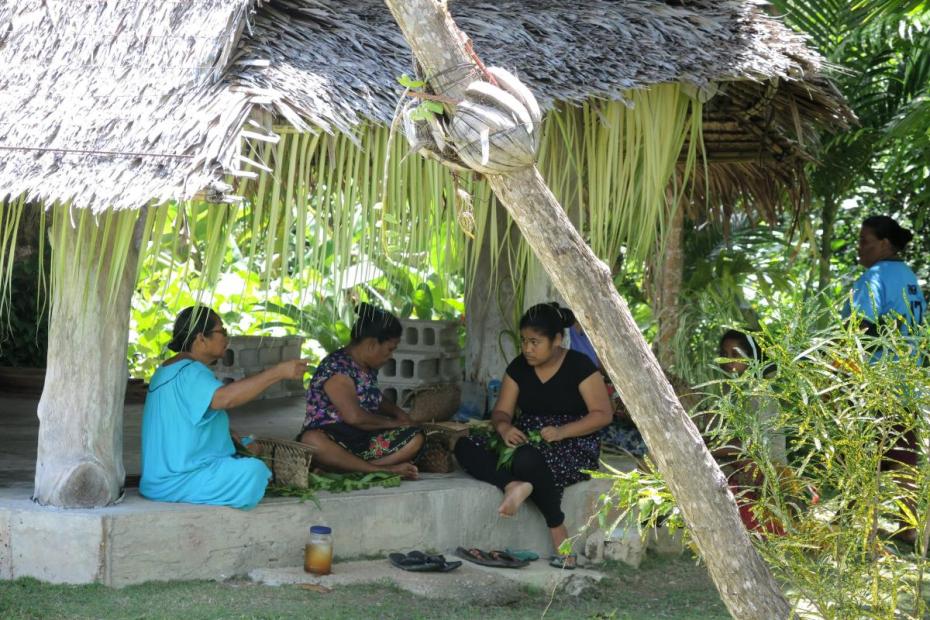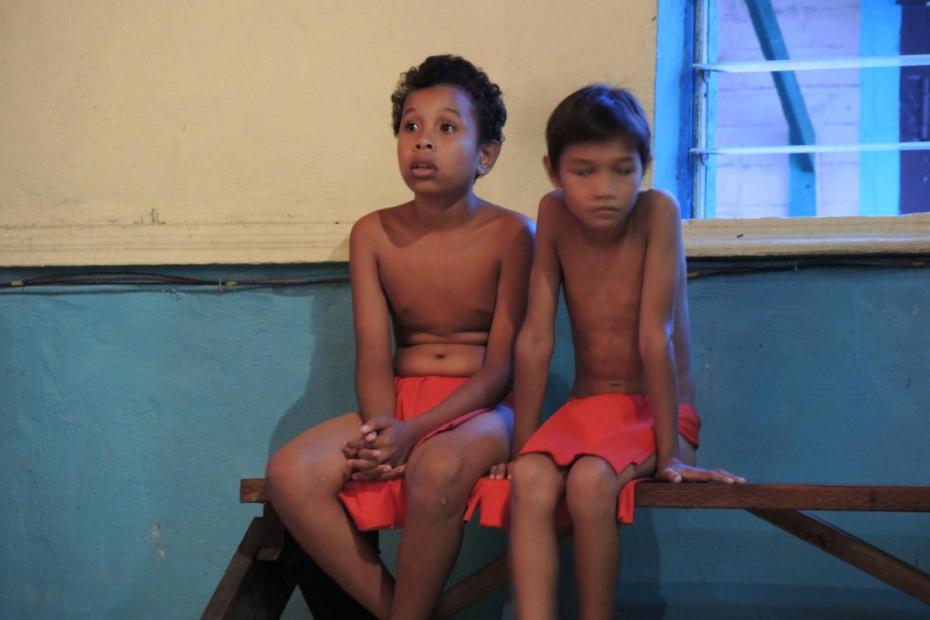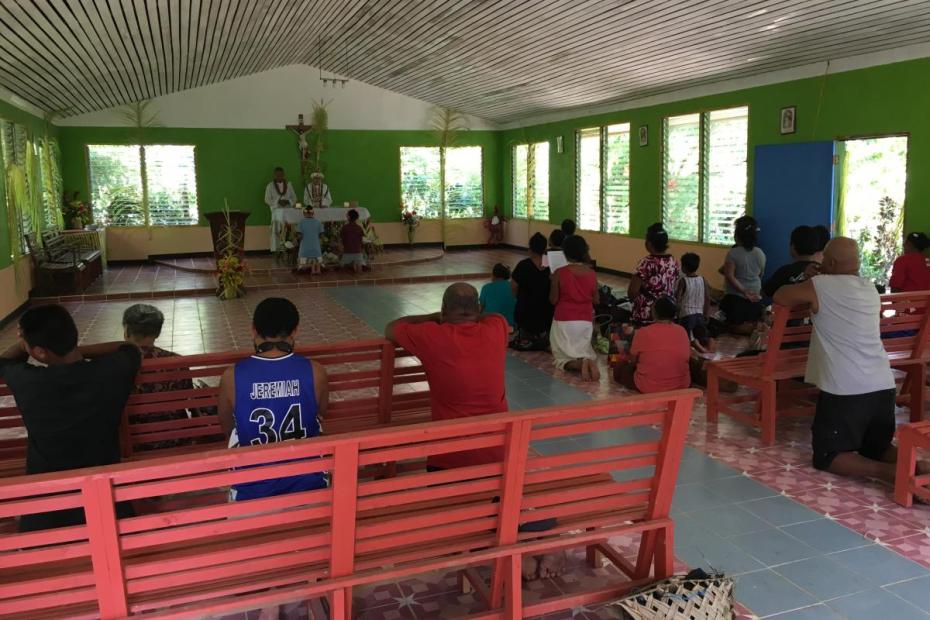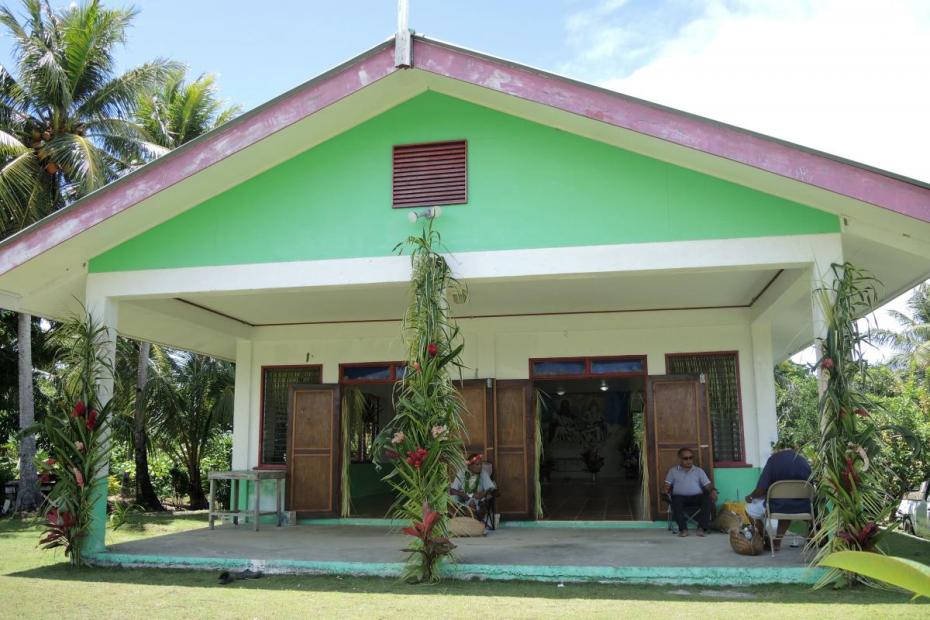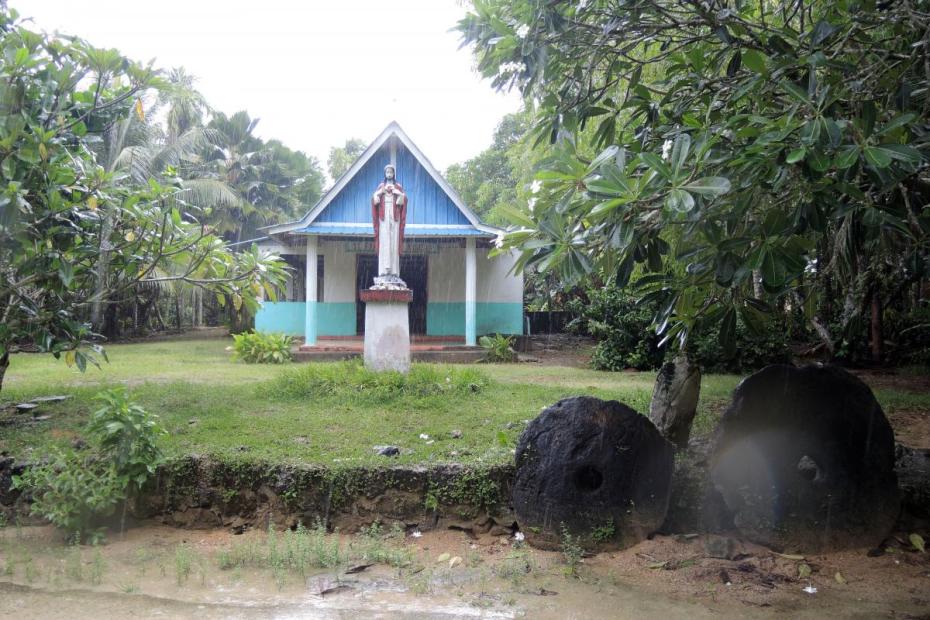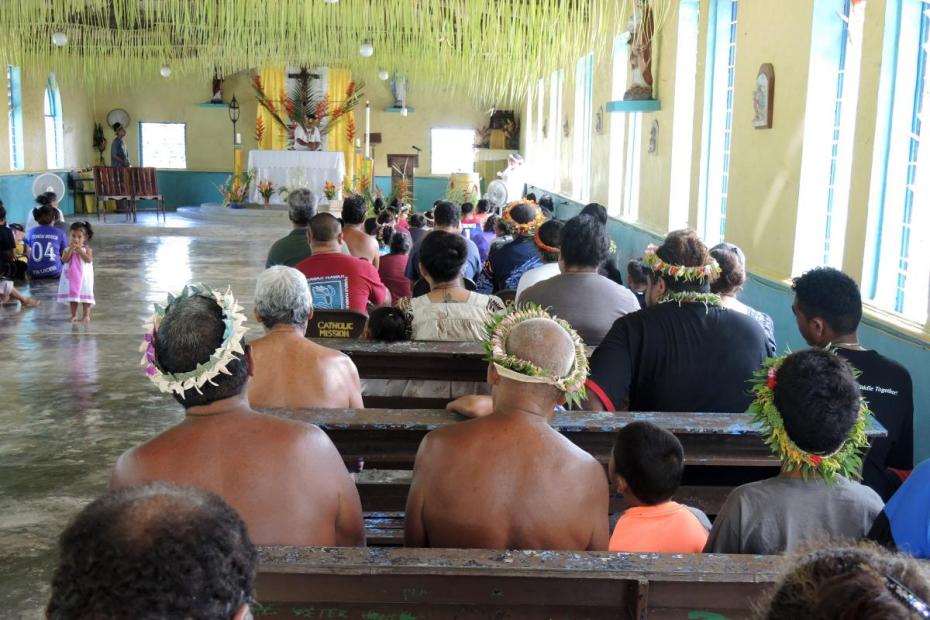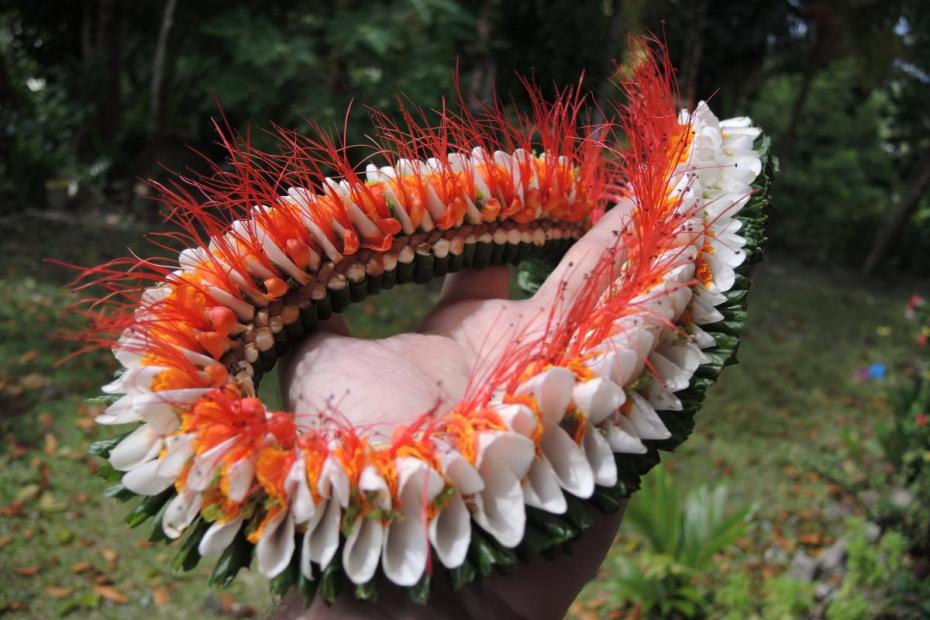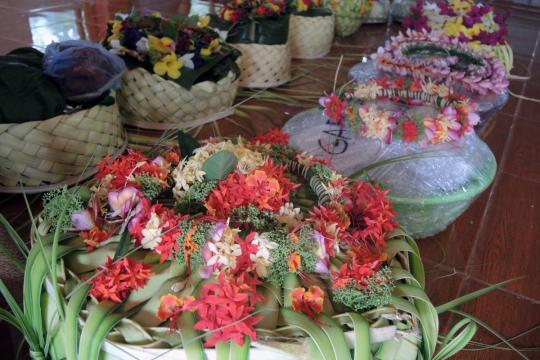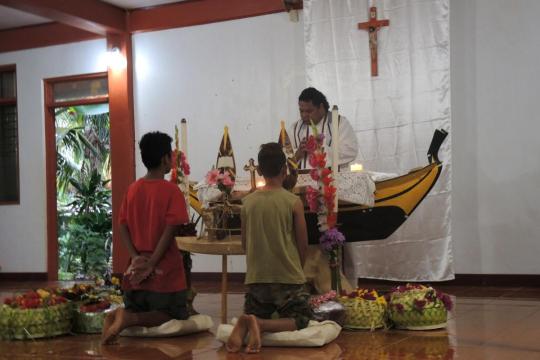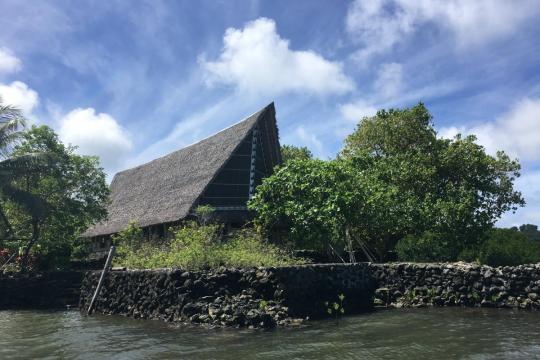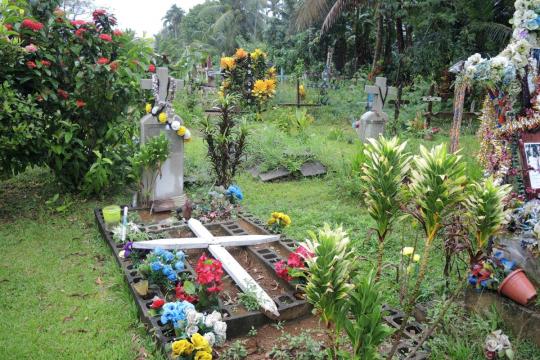Geographically and politically, “Yap” refers to the westernmost of the four states of the Federated States of Micronesia (FSM), and to the four high, practically contiguous islands of Yap (Waqab in Yapese) where the state capital is located and where the bulk of the population (7,371 of the state’s 11,377 inhabitants) lives.1 Culturally and linguistically, “Yap proper,” as the four high islands are sometimes called, is quite distinct not only from rest of Micronesia, but also from Yap state’s 13 other “Outer Islands,” which stretch across a 1,000 km arc mostly to the west of Yap proper. Outer Islanders speak Ulithian, Woleaian, and Chuukese languages, which bear no relation to the Yapese language. Today, English is the language that allows the state’s peoples to interact in shared endeavors, and is the language of classroom instruction, though the local languages largely remain the language of daily life.2
Yap is the most heavily Catholic of the states in the FSM. According to the 2010 state census, about 82% of Yap state residents (73.8% of people from Yap proper, 96.2% of Outer Islanders) are Catholic. The remainder are distributed among about 20 Protestant churches, the Mormon church, and other faiths.3
Yapese and other Micronesians often say that Yapese are especially tenacious in their adherence to traditional customs, though it’s certainly true that many other Micronesian islands are quite traditional in their own ways, and some interviewees were quick to point out ways that the culture is adaptive, even as it is the elders who ultimately decide how it will adapt. Literacy is relatively high, and about two-thirds of adults (75% of males, 59% of females) over 25 in Yap proper have a high school degree, but it is also true that at least half of Yapese live at a subsistence level, providing for most of their needs by fishing and small-scale farming.4 Traditional chiefs still play an important role in daily life and politics, and many traditional institutions and customs are strong. Family and gender roles are determinative in daily life, and an ethic of subordination of personal desire to family and community needs dominates.
Though this account concerns a quite small community of people compared to the world’s billion-plus Catholics, the ways that Yapese culture interacts with Catholicism are intriguing. Rituals like the Good Friday wailing ritual known as doloolow, and the Christmas and Easter dances, stand out in particular.
The entries on Yap reflect visits and interviews in 2018 on the four main, nearly contiguous high islands that comprise “Yap proper.”5 These are collectively home to two parishes, a Catholic grammar school and high school, and many sub-parishes and chapels. In recent decades, though, many Outer Islanders have moved to Yap’s main islands, and more of the clergy is from the Outer Islands than from Yap. Because of this the range of liturgies and the interviews that inform these entries here include perspectives from both Yapese and Outer Islanders, particularly people from Ulithi and Fais.6 Even so, beyond some broad stroke observations, the cultural diversity of those islands cannot be fully represented here.
Historical background
For centuries Yap was the center of a large trade network with other islands, and exerted political dominance over its outer islands. A population that could have been larger than today’s population lived in villages that competed with one another for status and resources. Precolonial Yapese had elaborate creation myths, and believed in nature spirits who might cause harm if proper precautions were not taken.
Spaniards visited Yap and its outer islands in the 1500s and claimed sovereignty there, but Yapese were legendarily resistant to outside influences, including missionaries, until 1886, when Spain began to exert political control and established a settlement. By that time, even limited prior encounters had brought European diseases that had radically depopulated the islands.7 Spanish Capuchin missionaries began the work of evangelizing, but were replaced by Germans when Spain sold the territory in 1899.8 In 1910, when German anthropologists were working to record the religion of Yap, “the old religion was already very close to forgotten—even by the priests in charge of the main shrines… and the myths about the gods varied greatly from district to district.”9
Japan ruled the islands from 1914 through most of World War II, and prohibited indigenous religious practices. Catholicism, allowed but not encouraged by the Japanese, filled the gap, though the Japanese insisted that the clergy had to come not from Germany but from a neutral country, so Rome sent Spanish Jesuits.10 Despite many significant ups and downs, the population of Catholics in Yap proper rose from 1,000 (about an eighth of the population) in 1899 to two-thirds of the population by 1941 and the proportion on many of Yap’s Outer Islands was even higher, though these were only visited by a priest three to four times a year.11 Lay catechists played a central role in that work on all the islands. World War II brought harsher and harsher restrictions, culminating in the execution of three Jesuits and a Filipino family by the Japanese.12
After the war, the United States governed the territory under a United Nations mandate until 1986, when Yap joined the three other states in the region to form the Federated States of Micronesia, which is organized in a Compact of Association with the United States. American Jesuits took the place of Spaniards, and were helped by local lay catechists, as the islands and the churches rebuilt from the war. Expansion of the faith to the Outer Islands continued. Many aspects of traditional cultural life, including men’s houses, canoe building, traditional funerals, and dance were restored, though others, including the women’s menstrual houses, were ended, because they kept women from attending church.13 Eventually, Yapese and Outer Island clergy and laypeople took over the leading role of shaping Catholic life, but several American Jesuits continue to work there as well.
Feet in two worlds
External signs of Yap’s traditional culture endure all over the island. Large, thatched and peaked faluw, or men’s houses, dot the shoreline, and similar thatched p'eebaay, community meeting houses, show up from place to place, including on some church grounds. Ancient, large circular stone money pieces called rai lean up against walls and buildings in many parts of the island, also, too, on some church properties.14 Men and women sometimes wear only skirts, with no shirts, in public settings, including to church. Weaving, dancing and boatbuilding traditions are carefully cultivated and passed on.
Less visible, but very important cultural norms have an even more significant role in daily life. Local chiefs play a powerful role in daily life, and government figures often defer to them. Chiefs are treated as almost sacred figures, but are not monarchs. Decision-making about important changes is a group responsibility, facilitated publicly by elder males. “In a public council all members of the village may come and listen, but only the ranking estate leaders of the village may talk… Decisions of the council are reached by consensus. Issues are discussed until public consensus is reached, or until a consensus is deemed impossible and the issue is dropped.”15 One interviewee described a similar situation in his Outer Island home. Young people like him do not speak up in deliberative meetings, even though it is expected that they attend. Elders lead the communal deliberation, and their word is final. Even if a younger person thinks he or she has a better idea, he or she would be expected to be quiet and deferential in front of elders.
One Outer Islander emphasized that while it is common to speak of “tradition” governing life on Yap and the Outer Islands, the “traditional” rules that govern people are not as static and unchanging as they might sound. It takes time and consensus to change them. What seems to be most clear is that the process is determinative, and that the rules are definite until people agree otherwise.
Yap has two international flights per week, both of which arrive and depart after midnight, to and from Guam, plus a few small propellor planes and a government boat to the Outer Islands. Ships from abroad occasionally dock with supplies in the port. As of April 2018, internet links were quite slow, but high speed internet lines were being installed and due to come online that summer. With only 50 tourists a week in peak season, mostly divers, Yapese traditional culture has not really been reorganized into a tourist commodity. Some villages and sites even remain closed to outsiders. Aspects of traditional culture are played out in intensive public performances on Yap Day (March 1), a modern invention designed to showcase traditional culture, but Yap Day is designed primarily to keep the culture alive and salient for the Yapese themselves, not as a tourist attraction.
Yap’s geographical isolation is counterbalanced by the fact that more than half of households in Yap proper have an immediate family member residing abroad—44% have one in the mainland U.S.A., about 13% have someone in Hawaii, and about 22% have someone on Guam. Even in the Outer Islands, 29% have a family member living outside the “Summary Analysis of Key Indicators from the FSM 2010 Census of Population and Housing," http://prism.spc.int/images/census_reports/FSM_2010_Census_Indicators_Final.pdf, p. 10.FSM.16
In Catholic life and practice
Summarizing how the Yapese cultural context influences Catholicism is a complex task. Even interviewees who were highly educated and spent some time in foreign contexts found it difficult to articulate how Catholicism and traditional culture impact each other. Some aspects of traditional culture have clearly long disappeared, but how the ones that endure are impacted by Catholicism, or how Catholicism is read differently through Yapese eyes is not always easy to determine.
The most obvious way to examine the impact is to point to some of the tangible, material cultural features that make Yapese Catholicism distinctive. The look of the churches; the tendency of many worshippers to sit on the floor; the nuunuw, the garland of fresh woven flowers and leaves that are offered to the celebrant of the liturgy with the offertory, and are worn to Mass on special occasions by lay attendees and exchanged at the Kiss of Peace; rituals as unique as the Good Friday wailing ceremony known as a doloolow’, or the women’s Christmas and Easter Vigil dances at Mass; the altar girls wearing only grass skirts and nuunuw, as was the case at one village church, and altar boys dressed only in a red thu (a three-piece loin cloth) at another, are vivid examples.17
Other cultural elements are difficult to tease out and less tangible, but no less important. They shape how people understand what it means to be a good person, and are the lens through which Yapese people read and perceive scripture and church teachings, prioritizing some and deprioritizing others.
Anthropologist C. Jason Throop has explored the core moral convictions present in Yapese culture in some depth. He writes, “Simply put, a virtuous person in Yap is understood to be an individual who is able to sacrifice his or her individual desires, wants, wishes, feelings, opinions and thoughts to the dictates of the family, village and community.”18 This ethic certainly resonates with major themes in scripture, from Jesus’ Incarnation to his Passion. Yapese are aware of the costs entailed in surrendering to the needs of others, but are less likely than in many cultures to lament self-sacrifice as unjust. Catholicism might thus be regarded as a faith that complements and reinforces those values, but does not necessarily import them.
Throop writes elsewhere, “According to one of the elders [whom he interviewed], the concept of ‘freedom’ and ‘free will’ (puuf rogon u fithikag) is not a Yapese concept (gaathii yalean nu Waqab). She believed that the church and various colonial presences had introduced it to Yap. She added that even with the concept being used regularly in the context of everyday talk, ‘we are never free.’ In her estimation, there are always matoochiyal (‘rules,’ ‘laws’) and yalean (‘traditions,’ ‘relationships’) that restrict an individual’s behavior. An individual is never able to do what he or she likes or wants at anytime he or she pleases.”19 A ethical emphasis on obligation, rather than individual human rights, or of finding some personal freedom in and through faith, seems out of place in this context. Finding oneself, becoming internally or externally “free” would not be what religion is “for” to Yapese people.
Individual wealth accumulation is looked down upon in Yap. Relationships demand—and social status derives from—high levels of generosity, especially with food. In traditional culture, villages tried to outdo one another in terms of what they gave away. The cycle of giving away does entail return obligations, but that’s different from an ethic of individual accumulation. Gospel and Catholic teachings on this are resonant in Yap.
Marriage and family still overwhelmingly fall to the “traditional” sphere, and missionaries for generations have made only minor headway on this issue. Interviewees have a clear understanding of what church expectations are about marriage, but traditional norms are powerful. Church marriage often occurs (or is sought) only late in life, either when it is necessary as a legal matter, or when someone recognizes his or her mortality.
The primacy in traditional culture of deliberate, thoughtful, communal decision-making carries over into Catholic life. While clergy have autonomy in certain important ways, they still have to negotiate with chiefs on many matters, just as the state government does, and even often deliberate with their own congregations. To do otherwise would often lower, not enhance, their authority. Knowing your place in the kinship and village hierarchies is essential in all interactions. Asserting yourself beyond your status will not help you, and generally will reflect badly on you. Clergy have authority over many aspects of church life, but have to respect boundaries beyond that. In a culture where men meet for extensive discussions to plan before they go fishing on any day, parish councils are also said to be especially deliberative and consensus oriented.
The impact of traditional culture on worship
One priest from the Outer Islands cited an example of how much traditional culture has a hold on him, even though he is exempt from many of those rules when he acts as a priest. He was invited to his chief’s house to anoint him when he was sick, but the norms of deference, and the taboo against touching the chief were so strong that he desperately hoped for an outsider priest to come and anoint the chief.
It was difficult to get a picture of how religion was practiced at home. On one Outer Island, the Rosary was said to be an important form of devotion at home. On Yap proper, one interviewee mentioned a small prayer group that features Bible reading, singing and the Rosary. Another mentioned a different small Bible and faith sharing group.
The Catholic sphere and the tribal sphere
When talking about values and religion, interviewees in Yap typically appealed to one of two sources of legitimation: the traditional and the Catholic. In some instances, each was described as an independent sphere. Priests clearly had authority in some matters and places, chiefs in others. Chiefs and the tradition, one man said, have made accommodations to the Church that might never have been allowed otherwise, “because God is above all,” which allows the Church to have an effect that can seem radical by Yapese norms. One woman interviewee recalled that when she was young, lower status people could not eat from the pots of higher status people, but that eventually changed island-wide she said, because clergy insisted it not be followed at Church and Catholic school events.
During this research, it was difficult to determine how or even whether there were places where the traditional and religious spheres came into conflict. Interviewees seemed puzzled when questions about that were posed. Potential conflict could revolve around enduring traditions in honor of ancestors, as well as spirits and divination. Yapese said that these are not traditions that endure to any degree that conflicts with Catholic belief, but by their own admission, Yapese tend to be especially circumspect. One interviewee was explicit in describing ways that she thought foreign anthropologists had misconstrued elements of Yapese life, and made them look bad, and did not want to see that repeated in any way in this work.20 Another interviewee indicated that traditional local herbal medicine and healing practices traditions do endure (these originally included a spiritual or supernatural component). She said that people saw them as medicines, not magic or something with spiritual power, though she also said that it was a taboo to talk specifically about the practices.21
Forgiveness and reconciliation
The Yapese values described above—generosity, respect for and deference to elders, self-control, self-surrender to the good of the community, self-deprecation—might leave the impression of a society without conflict. But Yap is not immune to conflict and violence. Like all people, Yapese fail at times to live up to the values they regard as most important.
Often, the violence that does happen occurs when men are drinking. From the moment it was first imported by Westerners, alcohol has been a source of difficulty in Yap. Early missionaries reported a large number of deaths from uncontrolled binge drinking.22 At times since then drinking has been regulated. Like people on Chuuk, Yapese Outer Islanders have remarkable rituals of communal reconciliation, whereby the whole family of the person who committed an offense makes amends to the whole family of the victimized. By making the extended families of the perpetrator and the victim accountable to one another, the system, interviewees said, is successful at preventing cycles of retribution.
The cusp of more change?
Certainly traditional culture and Catholicism are not the only “spheres” affecting life on the island. Other forces of modernity—political, economic, and cultural—are all part of Yapese life. Media access, once primarily linked to radio, is increasing and soon to leap forward via broadband access, and a significant number of Yapese have lived outside of Micronesia or have family who do.
In recent decades, affiliation to the Church has eroded to a noticeable degree. Interviewees talked about how many people, on Yap and the Outer Islands, were going to Seventh Day Adventist, Baptist, Mormon, and other churches. For small islands, there seemed to be a huge array of proselytizers. Some of the new faiths seemed to emphasize ways of worship that were highly emotional, physical, and “un-Yapese,” with people “moving and screaming, ‘Rejoice!’” one interviewee lamented. Openness to the new faiths, which the chiefs often found disruptive, suggested some of the ways that traditional culture was pliable, but interviewees suggested that in some cases it was the chiefs themselves who were the evangelizers of other faiths.
Yap may be at the cusp of another profound social transformation. A Chinese firm has been offering 99-year leases for property in Yap, with the aim of developing it intensively for tourists from China (land on Yap cannot be sold to outsiders), with golf courses and perhaps even a casino.23 Church opposition to the move, out of a belief that such development will radically upend much that Yapese hold dear, has apparently alienated many in the Catholic community who want to benefit from the rents.
- 1Summary Analysis of Key Indicators from the FSM 2010 Census of Population and Housing, http://prism.spc.int/images/census_reports/FSM_2010_Census_Indicators_Final.pdf, p. 8.
- 2Because of the Outer Islanders who have moved to Yap proper, only about 70% of people living there speak Yapese, whereas 88% speak English. On Yap state’s Outer Islands, only 1% speak Yapese, but 73% speak English. Interestingly, none of the Outer Islands-born Catholic clergy speaks Yapese, and one person claimed that no American who worked for the Peace Corps had ever managed to learn Yapese with any facility during a two-year stint there. English is the language that allows local language speakers to overcome their differences.
- 3Calculated from Table 15.5, “Religious Membership by Region and Sex: 1994, 2000 and 2010” Yap State Statistical Yearbook, Yap Branch Statistical Office, Colonia, Yap, FSM, 2011, p. 194. The percentage of Catholics has declined very slightly in recent decades, but almost every interviewee, including the people at the statistical office, predicted that the 2020 census would show significant decline, both on Yap and in the Outer Islands. About 2.5% of the population professes no religious affiliation, a proportion that actually declined by almost 60% from 1994 to 2010.
- 4Literacy is defined as being able to “read, write and understand a simple sentence in any language.” See Appendix 1 in Summary Analysis of Key Indicators from the FSM 2010 Census of Population and Housing, http://prism.spc.int/images/census_reports/FSM_2010_Census_Indicators_Final.pdf, p. 8-9.
- 5Today it is possible to drive easily between three of these islands, and the uninitiated could be forgiven for not knowing that they are three separate islands. The fourth, accessible by boat, is by far the least inhabited.
- 6The entries here are based on a week of participant observation on the main islands of Yap, interviews with 11 Yapese and Outer Island Catholics, and less formal discussions with a dozen others during Holy Week 2018. Special thanks to Fr. Kelly Yalmadau, Fr. Moses Tashibelit, and Fr. Cuthbert Yiftheg for their hospitality, and to Fr. John Mulreany, S.J., Fr. Jack Mattimore, S.J. and Michael Lamanna, S.J. for their many kindnesses. All of them helped with introductions and access.
- 7C. Jason Throop, Suffering and Sentiment: Exploring the Vicissitudes of Experience and Pain in Yap (University of California, 2010), 29.
- 8For an overview of Yapese Catholic history from which the subsequent account is partially drawn, see Francis X. Hezel, S.J., “The Catholic Church in Yap” in The Catholic Church in Micronesia (Pohnpei, Micronesian Seminar, 2003), 1-41.
- 9Jay D. Dobbin, Summoning the Powers Beyond: Traditional Religions in Micronesia (Honolulu: University of Hawaiʻi Press, 2011), 140. Chapter seven of this book is dedicated to the old religion of Yap.
- 10Throop, Suffering and Sentiment, 31-32; Francis X. Hezel, S.J., Strangers in their Own Land: A Century of Colonial Rule in the Caroline and Marshall Islands (Honolulu, University of Hawai’i Press, 1995), 171.
- 11Francis X. Hezel, S.J., The Catholic Church in Micronesia, 17-27. Hezel argues elsewhere, in Strangers in their Own Land, that though the war period ended very badly for the Spanish missionaries and many Micronesians, the Church had its greatest missionary success on Yap in the early years of Japanese rule, even as Micronesia initially achieved unprecedented economic prosperity. “Catholicism… served as a buffer between [Yapese] and the foreign government.” Strangers, 179. During wartime, from 1939 onwards, the Jesuits were largely prevented from working.
- 12Hezel, The Catholic Church in Micronesia, 27.
- 13Throop, Suffering and Sentiment, 34; Hezel, Strangers, 277.
- 14The stone money pieces, the size of millstones, stay fixed in one place, but ownership of all or part of them can be transferred between people. Local people are aware who owns the value ascribed to each stone. The island has Western-style banks, but still also uses the stone money as a way to store value. Interestingly, the church properties on which the rai are located often owned by the villages, not the church, and the ownership of the stone’s value belongs to others as well.
- 15Sherwood Lingenfelter, Yap: Political Leadership and Culture Change in an Island Society (Honolulu: University of Hawai‘i, 1975), 114-115, as cited in Glenn Petersen, Traditional Micronesian Societies: Adaptation, Integration, and Political Organization in the Central Pacific (Honolulu: University of Hawai’i, 2009), 137.
- 16 Some young people move to the United States to study, and American naval ships sometimes visit. But on Yap and in familial relations, American culture has had limited, scattered impact. Individuals still have, by American standards, quite limited freedom to choose their direction independently.
- 17The doloolow and the Easter vigil dance were the two cultural events first cited to me as reasons to visit Yap, as encapsulations of the relations between Yapese culture and Catholicism.
- 18C. Jason Throop, “‘Becoming Beautiful in the Dance’: On the Formation of Ethical Modalities of Being in Yap, Federated States of Micronesia” Oceania 79 (2009): 182.
- 19Throop, Suffering and Sentiment, 142, italics added.
- 20This was around claims of a historic and enduring “caste” structure in Yap, an issue not otherwise developed here because its contemporary relevance is not clear, though there were once some sort of rules that seem to have impacted Catholic practice.
- 21Anthropologist Jason Throop has noted that part of the protection of information about healing that he encountered came from a sense that the more commonly known medicinal information was, the less effective the medicine would be, which certainly suggests some supernatural component to its efficacy. Throop, Suffering and Sentiment, 121.
- 22Hezel, Strangers, 72-73.
- 23For one account, see Daniel Lim, “This Pacific Island Is Caught in a Global Power Struggle (And It's Not Guam)” National Geographic, August 2017, online at https://news.nationalgeographic.com/2017/08/yap-pacific-island-tourism-development-conservation-china-us-cofa/
